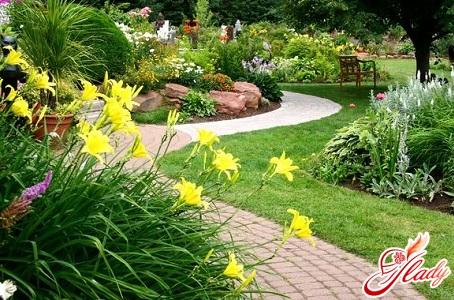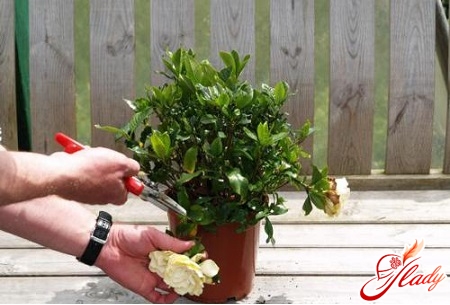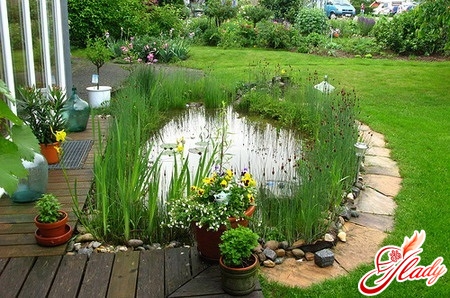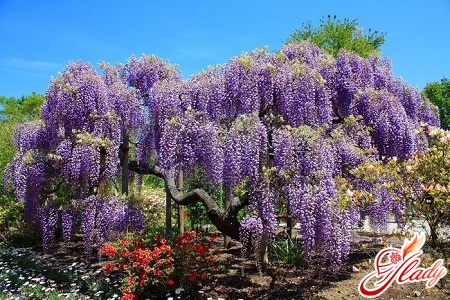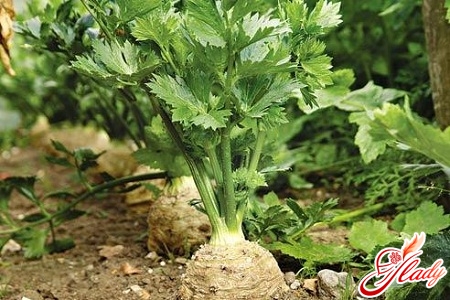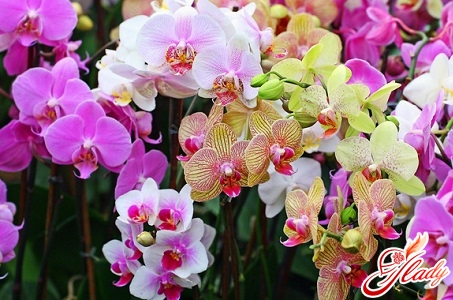 Orchid - a flower very capricious, but neither trueprofessionals-flower growers, amateurs-amateurs do not stop this. The most of the family of orchids is adapted to room conditions phalaenopsis, native to the tropical jungle; by right he has won his place in the apartment and for a long time has been attracting the owners with his exotic appearance and almost year-round flowering. In addition to phalaenopsis, there are many other types of orchids that are becoming more popular with home-grown growers. But, admiring your flowering plants, one day you can find an obvious sign of an orchid disease - yellowed leaves. This may not be one reason. To understand what caused the disease, it is necessary to consider several important points - the conditions that must be observed when buying and maintaining this exotic plant.
Orchid - a flower very capricious, but neither trueprofessionals-flower growers, amateurs-amateurs do not stop this. The most of the family of orchids is adapted to room conditions phalaenopsis, native to the tropical jungle; by right he has won his place in the apartment and for a long time has been attracting the owners with his exotic appearance and almost year-round flowering. In addition to phalaenopsis, there are many other types of orchids that are becoming more popular with home-grown growers. But, admiring your flowering plants, one day you can find an obvious sign of an orchid disease - yellowed leaves. This may not be one reason. To understand what caused the disease, it is necessary to consider several important points - the conditions that must be observed when buying and maintaining this exotic plant.
How to buy orchids
Be careful when buying orchids! First, when buying a plant, pay attention to whether there are any damages on the flower. Of course, there should not be any dark spots on the leaves and bulbs (bulbs are organs of some species of orchids that are intended for the accumulation of nutrients). If the cuts on the leaves are visible, this may indicate that the seller has thus removed the affected areas. And this can not always save the flower from spreading the infection further along the trunk. Secondly, if possible, explore the roots. Ideally, they should be dense, light gray, sometimes greenish. Soil should not be oversaturated with moisture, otherwise it can lead to decay of the entire root system and, accordingly, to the complete death of the orchid. Third, the flower can experience real stress when moving from one environment to another. Be careful in handling it and try to create the first time the best possible conditions for its content. A few days later, your orchid adapts to local conditions and will please you with its flowering. 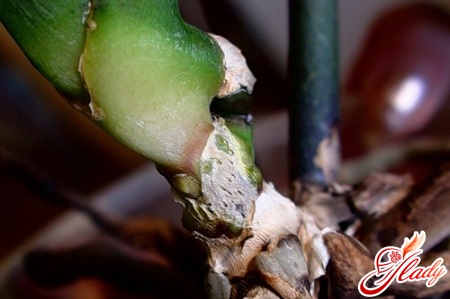
Conditions of detention
When choosing a place for a flower, follow the generalrules: being in a sunny place, an orchid can get burned, and if you plant the plant far from the window, it simply does not have enough light and sun energy for flowering. Conduct a visual inspection of the plant: if it lacks light, the leaves will turn dark green. And dry spots and yellowed leaves indicate the opposite - about the excess of the sun. Almost all types of indoor orchids can be kept at a temperature of twenty to twenty-eight degrees. In this case, the difference in four to five degrees between night and day temperature is important for flowering. You will accelerate the germination of the peduncle, providing the necessary difference in heat and coolness. Mindful of the fact that most orchids are from the humid tropics, it will not be superfluous to humidify the air. You can put a special tray with water or an artificial decorative fountain, and of course, do not forget to spray the plants from the spray gun. The optimum humidity is 70-80%. As for watering a plant, it is necessary to adhere to the following rule: it is better to be underfilled than overflow. The earth should be moist, but not wet. The roots of the flower can not be left in the water. Watering is necessary often, but not much. And, of course, change the intensity of watering with the arrival of another season. In case the plant lacks water, it will look outwardly, with wrinkled leaves and bulbs. But overabundance of moisture will indicate the sodden yellowed leaves and decaying roots. And, of course, like any other plant, orchids need fertilizer. The best way is to purchase garden fertilizers in specialized stores, and you need to buy fertilizers that are specifically for feeding orchids. It will be enough to feed the plant once every two weeks. When transplanting an orchid, be especially attentive to its roots. Dry or rotting roots should be cut. Substrate use only a special one, designed for orchids, and in no case sprinkle the top of the plant with soil. After the transplant, squeeze a little soil and leave the orchid in the shade for three or four days. Knowing simple rules and adhering to the recommendations listed above, you can prolong the life of the flower and easily identify the etiology of the yellowed leaves. 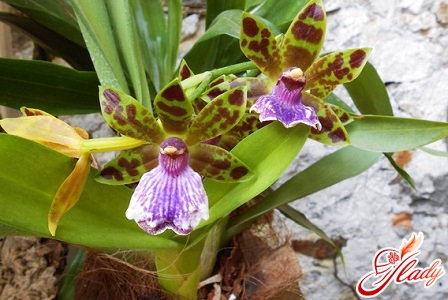
Possible causes of yellowing of leaves
To begin, clarify how yellownessspread over the plant. If the yellowed only one or two of the bottom sheets, and the others look as they are - saturated, healthy - then you have no cause for concern. Orchid only sheds old foliage. Like all plants, the leaves of the orchid must be renewed, this is a natural process in nature. So, the first possible cause of yellowing the plant is a natural change of leaves. Depending on the type of orchid, this process can be repeated in a year, two to three years, and in some cases every five years. As soon as the leaf completely withers, it is easily separated, and you will only have to remove it. The flower spike is also able to turn yellow after the end of the flowering cycle. It must be carefully cut with scissors or a knife. The second cause may be sunburn. Notice which side the leaves turn yellow. If the yellowed side is directed directly to the window, then undoubtedly it can be called the reason for the excessive sun. Often yellowing from burns is accompanied by peeling of the leaf. Particularly affected in the sun are varieties with light green leaves. What to do in this situation? Just remove the flower from the scorching rays or a little darken the windowsill. Often, a possible cause of yellowing of leaves may, on the contrary, be a lack of light. In this case, the orchid leaf turns yellow at the base and falls off. This is fraught with the possible death of the whole plant, because the stalk zone, which is directly below the leaf, also dries. Lack of light has a negative effect on the plant gradually, you can detect this symptom only one or two years after the onset of the disease. And then the flower will be saved only by cutting off all the damaged leaves and part of the diseased stem. The chances for the restoration of the whole plant will be proportional to the length of its part, remaining healthy The fourth reason, which usually turns yellow orchid leaf, is a lack of moisture. A weak, unsatisfactory watering of the soil will ruin your plant. Do not forget to water the flower in time, watch the state of the earth. But you can not water the orchid abundantly, but rarely. As already mentioned above, the soil should be wet, not wet. However, regular excessive watering, and too generous spraying can lead to stagnation of moisture in the pot and cause yellow leaves. Excessive moisture leads to rotting of the roots, which in turn is an obstacle to the movement of water further along the stem. In addition, moisture leads to the appearance of fungal diseases. Having an orchid on the window, do not forget that one of the common causes of yellowed leaves is the hot dry air emanating from the batteries. In addition to the fact that artificial heating negatively affects the humidity in the room, the roots of the plant also quickly dry up and die. Do not be stingy, buy a humidifier, at the very least, place a container with water next to the orchid. If the stalk of the orchid and its leaves suddenly became yellow for no apparent reason for a short time, then the flower most likely affected the bacterial or fungal infection. The chances of recovering the plant after removing the infected area are very small. Another banal reason for the yellowing of the leaves, which also takes place is: your pot became an orchid is simply small, and the overgrown root system no longer fits in the container, causing it to squeeze and deform. Elementarily transplant the plant in a pot, which is one to two centimeters larger than the previous capacity. Just be very careful with the roots during the transplant! A possible cause of yellowing of leaves in an orchid may be a lack of potassium. There is a biochemical process: potassium, which is not enough in the plant, is redistributed from old tissues to new ones, and the more mature leaves turn yellow and die. In this case, a lure with a high potassium content is needed. Also for the plant is fraught with yellowing of the leaves and the poverty of the soil substrate itself, namely the lack of iron contained in it. Tap water further worsens the situation, so the orchid should be watered with filtered water; and yet it must be transplanted in time and used fertilizers with iron. A similar situation with leaves occurs when there is not enough nitrogen: the leaves turn yellow, but do not fall off. It is advisable to use fertilizers with nitrogen to eliminate the defect of this element. A serious cause requiring immediate intervention is a chemical burn with immoderate soil fertilization. In organics there is a concentrated spectrum of salts (phosphoric, potassium, etc.), and the root system of orchids is very vulnerable. In this case, before fertilizing the flower, dilute the mixture with water to obtain a less saturated concentrate for irrigation. It is possible that for the rapid growth of the plant the seller has overdone with stimulants. And only after one or two years the yellowed leaves fell, and their further growth stopped. Is it possible to save a flower in this case? You can, but have patience. Suspend the feeding of the orchid for a while, then start to fertilize it with a weak solution from time to time. Next, use a nitrogen fertilizer to grow new leaves. With yellow leaves, a special place in the possible causes of the disease is occupied by harmful insects that affect the plant. Unfortunately, as yet there are no specialized drugs for treatment of orchids, and in this case one should be guided by the general methods of healing used for other colors: spraying with special solutions, processing leaves and the like. As you can see, various factors can affect the causes of yellowing of orchid leaves: illiterate care, poor lighting, thermal or chemical burns, low humidity, insufficient or excessive watering, root damage, small insect damage and other causes. Like any other flower, the orchid will experience discomfort with a sharp change in conditions, large temperature changes, which is also a common cause of yellowed leaves. Remember the golden rule of florists: prevention and proper care is much easier to provide than to save the plant. Follow these simple guidelines, and the orchid will answer you with its beauty, health and frequent flowering.




